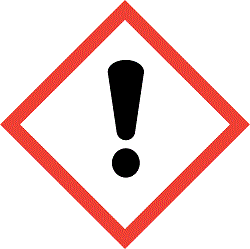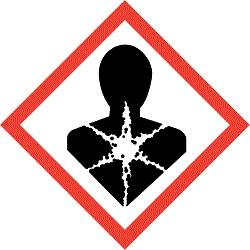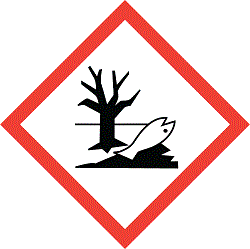
Example 4
The purpose of this example is to show calculation of Respiratory / Skin sensitisation according to Regulation (EC) No 1272/2008 (CLP).
There is a liquid mixture consisting of the following ingredients:
| Ingredient | Conc. % (w/w) | Classification | Specific Conc. Limits, M-factors and ATEs |
| Substance A | 0.3 |
Acute Tox. 3: H331 Eye Irrit. 2: H319 STOT SE 3: H335 Skin Irrit. 2: H315 Resp. Sens. 1: H334 Skin Sens. 1: H317 |
Resp. Sens. 1: H334: C ≥ 0.5 % Skin Sens. 1: H317: C ≥ 0.5 % |
| Substance B | 3.1 |
Muta. 2: H341 Acute Tox. 4: H332 Skin Sens. 1: H317 Aquatic Acute 1: H400 Aquatic Chronic 1: H410 |
− |
| Substance C | 2.2 |
Eye Dam. 1: H318 Resp. Sens. 1: H334 Aquatic Acute 1: H400 Aquatic Chronic 1: H410 |
− |
| Substance D | 9.5 |
STOT SE 3: H335 Skin Sens. 1: H317 |
− |
| Substance E | 0.08 | Skin Sens. 1: H317 | − |
| Water | 84.82 | − | − |
Calculation of mixture classification.
Following ingredients are classified as acute toxicants:
| − | Substance A: Acute Tox. 3: H331 (inhalation). |
| − | Substance B: Acute Tox. 4: H332 (inhalation). |
Because there are no data on LC50 (inhalation) the acute toxicity category for inhalation should be converted to Acute Toxicity Estimate (ATE) (CLP, Annex I, Table 3.1.2).
Cut-off limits
| − | For 'Acute Tox. 1', 'Acute Tox. 2' and 'Acute Tox. 3' the cut-off limit 0.1 % is applied (CLP, Annex I, Table 1.1). Concentration of substance A is above this value, therefore, it is taken into account. |
| − | For 'Acute Tox. 4' the cut-off limit 1 % is applied (CLP, Annex I, Table 1.1). Concentration of substance B is above this value, therefore, it is taken into account. |
Specific and Generic concentration limits
Neither specific nor generic concentration limits are applied for acute toxicity.
Calculation of inhalation Acute Toxicity
There are two ingredients (A and B) classified as acute toxicants via inhalation route. Because no mixture's physical forms of inhalation routes of exposure are known, all possible routes should be calculated separately. Inhalation exposure may be calculated for three physical forms: (1) gases, (2) vapours and (3) dust/mist. Because mixture is a liquid the gaseous form may be omitted. During the usage of the mixture it can not be excluded that mixture may forms vapours and/or mists, therefore, inhalation exposure should be calculated for 2nd and 3rd forms.
ATE values converted from inhalation (vapours) acute toxicity categories:
| − | Substance A: Acute Tox. 3: H331 -> ATE = 3 |
| − | Substance B: Acute Tox. 4: H332 -> ATE = 11 |
100 / ATE mix = conc. A / ATE A + conc. B / ATE B
100 / ATE mix = 0.3 / 3 + 3.1 / 11
ATE mix = 261.905
The value 261.905 is above 20.0 for vapours (CLP, Annex I, Table 3.1.2). This does not lead to acute toxicity via inhalation route.
ATE values converted from inhalation (mists) acute toxicity categories:
| − | Substance A: Acute Tox. 3: H331 -> ATE = 0.5 |
| − | Substance B: Acute Tox. 4: H332 -> ATE = 1.5 |
100 / ATE mix = conc. A / ATE A + conc. B / ATE B
100 / ATE mix = 0.3 / 0.5 + 3.1 / 1.5
ATE mix = 37.500
The value 37.500 is above 5.0 for dust/mist (CLP, Annex I, Table 3.1.2). This does not lead to acute toxicity via inhalation route.
Classification of the mixture
The mixture is not classified in category acute toxicity.
Following ingredients are classified as corrosive / irritant to skin:
| − | Substance A: Skin Irrit. 2: H315. |
The mixture's pH is between 2 and 11.5, this does not lead to classification 'Skin Corr. 1'. Mixture contains no ingredients leading to the application of non-additivity approach, therefore, Additivity approach is applied.
Cut-off limits
| − | For skin corrosion / irritation the cut-off limit 1 % is applied (CLP, Annex I, Table 1.1). Concentration of substance A is below this value, therefore, it is not taken into account. |
Because only substance A is classified as irritant to skin and its concentration is below the cut-off limit, there is no need to calculate classification corrosive / irritant to skin.
Classification of the mixture
The mixture is not classified in category corrosive / irritant to skin.
Following ingredients are classified as serious damage to eyes / eye irritation:
| − | Substance A: Eye Irrit. 2: H319. |
| − | Substance C: Eye Dam. 1: H318. |
The mixture's pH is between 2 and 11.5, this does not lead to classification 'Eye Dam. 1'. Mixture contains no ingredients leading to the application of non-additivity approach, therefore, Additivity approach is applied.
Cut-off limits
| − | For serious damage to eyes / eye irritation the cut-off limit 1 % is applied (CLP, Annex I, Table 1.1). Concentration of substance A is below this value, therefore, it is not taken into account. Concentration of substance C is above this value, therefore, it is taken into account. |
Specific and Generic concentration limits
| − | Because no specific concentration limits is applied for substance C, its concentration must be compared to generic concentration limits. |
Calculation of 'Eye Dam. 1'
| − | Concentration of substance C is below the generic concentration limit 3 % (CLP, Annex I, Table 3.3.3). This does not lead to classification 'Eye Dam. 1'. |
Calculation of 'Eye Irrit. 2'
| − | Concentration of substance C must be multiplied by 10.
10 × conc. C = 10 × 2.2 = 22 % The obtained value is above the generic concentration limit 10 % (CLP, Annex I, Table 3.3.3). This leads to classification Eye Irrit. 2 . |
Selection of hazard category
| − | The mixture is classified as 'Eye Irrit. 2'. |
Selection of hazard statements
| − | H319 corresponds to 'Eye Irrit. 2'. |
Selection of pictogram and signal word
| − | Pictogram GHS07 and signal word 'Warning' correspond to 'Eye Irrit. 2'. |
Selection of precautionary statements
| − | For H319 following precautionary statements are applied: P264, P280, P305+P351+P338, P337+P313. |
Following ingredients are classified as respiratory / skin sensitisers:
| − | Substance A: Resp. Sens. 1: H334 / Skin Sens. 1: H317. |
| − | Substance C: Resp. Sens. 1: H334. |
| − | Substance B: Skin Sens. 1: H317. |
| − | Substance D: Skin Sens. 1: H317. |
| − | Substance E: Skin Sens. 1: H317. |
Cut-off limits
| − | There is no generic cut-off limit for respiratory and skin sensitisation (CLP, Annex I, Table 1.1), therefore, any concentration of an ingredient with such classification is taken into account. |
Specific and Generic concentration limits
| − | Substance A has specific concentration limits (SCLs). Because SCL has a precedence over generic concentration limit, concentration of A must be compared to its SCLs. |
| − | Because no specific concentration limits are applied for other ingredients, their concentrations must be compared to generic concentration limits. |
Calculation of 'Resp. Sens. 1'
| − | Concentration of substance A is below its specific concentration limit 0.5 % for 'Resp. Sens. 1'. This does not lead to classification 'Resp. Sens. 1'. |
| − | Concentration of substance C is above the generic concentration limit 1.0 % (CLP, Annex I, Table 3.4.5). Because no sub-categorisation is required this leads to classification Resp. Sens. 1 . |
Calculation of 'Skin Sens. 1'
| − | Concentration of substance A is below its specific concentration limit 0.5 % for 'Skin Sens. 1'. This does not lead to classification 'Skin Sens. 1'. |
| − | Concentration of substance B is above the generic concentration limit 1.0 % (CLP, Annex I, Table 3.4.5). Because no sub-categorisation is required this leads to classification Skin Sens. 1 . |
| − | Concentration of substance D is above the generic concentration limit 1.0 % (CLP, Annex I, Table 3.4.5). Because no sub-categorisation is required this leads to classification Skin Sens. 1 . |
| − | Concentration of substance E is below the generic concentration limit 1.0 % (CLP, Annex I, Table 3.4.5). This does not lead to classification 'Skin Sens. 1'. |
Selection of hazard categories
| − | Because classification categories 'Resp. Sens. 1' and 'Skin Sens. 1' belong to different routes of exposure (respiratory and dermal) both of them must be selected. |
Selection of hazard statements
| − | H334 corresponds to 'Resp. Sens. 1'. |
| − | H317 corresponds to 'Skin Sens. 1'. |
Selection of pictogram and signal word
| − | Pictogram GHS08 and signal word 'Danger' correspond to 'Resp. Sens. 1'. |
| − | Pictogram GHS07 and signal word 'Warning' correspond to 'Skin Sens. 1'. |
| − | According to Article 26(1,d) of CLP the pictogram GHS08 must be selected. According to Article 20(3) of CLP if the signal word 'Danger' is used the 'Warning' is not used. |
Selection of precautionary statements
| − | For H334 following precautionary statements are applied: P261, P284, P304+P340, P342+P311, P501. |
| − | For H317 following precautionary statements are applied: P261, P272, P280, P302+P352, P333+P313, P321, P362+P364, P501. |
| − | For both H334 and H317 following precautionary statements are applied: P261, P272, P280, P284, P302+P352, P304+P340, P321, P333+P313, P342+P311, P362+P364, P501. |
Following ingredients are classified as germ cell mutagens:
| − | Substance B: Muta. 2: H341. |
Cut-off limits
| − | There is no generic cut-off limit for germ cell mutagenicity (CLP, Annex I, Table 1.1), therefore, any concentration of an ingredient with such classification is taken into account. |
Specific and Generic concentration limits
| − | Because no specific concentration limit is applied for substance B its concentration must be compared to generic concentration limit. |
Calculation of 'Muta. 2'
| − | Concentration of substance B is above the generic concentration limit 1.0 % (CLP, Annex I, Table 3.5.2). This leads to classification Muta. 2 . |
Selection of hazard category
| − | The mixture is classified as 'Muta. 2'. |
Selection of hazard statements
| − | H341 corresponds to 'Muta. 2'. |
Selection of pictogram and signal word
| − | Pictogram GHS08 and signal word 'Warning' correspond to 'Muta. 2'. |
Selection of precautionary statements
| − | For H341 following precautionary statements are applied: P201, P202, P280, P308+P313, P405, P501. |
Following ingredients are classified as specific target organ toxicity – single exposure (STOT SE):
| − | Substance A: STOT SE 3: H335. |
| − | Substance D: STOT SE 3: H335. |
Cut-off limits
| − | For 'STOT SE 3' the cut-off limit 1 % is applied (CLP, Annex I, Table 1.1). Concentration of substance A is below this value, therefore, it is not taken into account. Concentration of substance D is above this value, therefore, it is taken into account. |
Specific and Generic concentration limits
| − | Because no specific concentration limit is applied to substance D its concentration should be compared to generic concentration limit. |
Calculation of 'STOT SE 3: H335'
| − | Concentration of substance D is below the generic concentration limit 20 % (CLP, Annex I, 3.8.3.4.5). This does not lead to classification 'STOT SE 3: H335'. |
Classification of the mixture
The mixture is not classified in category specific target organ toxicity – single exposure.
Following ingredients are classified as hazardous to the aquatic environment:
| − | Substance B: Aquatic Acute 1: H400 / Aquatic Chronic 1: H410. |
| − | Substance C: Aquatic Acute 1: H400 / Aquatic Chronic 1: H410. |
Cut-off limits
For 'Aquatic Acute 1' and 'Aquatic Chronic 1' cut-off limit is calculated according to formula 0.1/M (CLP, Annex I, 4.1.3.1):
| − | There is no M-factor in Table 3 of Annex VI to CLP established for substance B. Person responsible for classification decided to use M = 1 for both 'Aquatic Acute 1' and 'Aquatic Chronic 1'. Concentration of substance B is above 0.1 % (0.1/1), therefore, B is taken into account for calculation of both 'Aquatic Acute 1' and 'Aquatic Chronic 1'. |
| − | There is no M-factor in Table 3 of Annex VI to CLP established for substance C. Person responsible for classification decided to use M = 1 for both 'Aquatic Acute 1' and 'Aquatic Chronic 1'. Concentration of substance C is above 0.1 % (0.1/1), therefore, C is taken into account for calculation of both 'Aquatic Acute 1' and 'Aquatic Chronic 1'. |
Specific and Generic concentration limits
Neither specific nor generic concentration limits are applied for acute toxicity.
Calculation of 'Aquatic Acute 1'
| − | Concentrations of substances B and C must be multiplied by their corresponding M-factors and obtained values must be summed.
(conc. B × M) + (conc. C × M) = (3.1 × 1) + (2.2 × 1) = 5.3 The obtained value is below 25 % (CLP, Annex I, 4.1.3.5.5.3.1 and Table 4.1.1). This does not lead to classification 'Aquatic Acute 1'. |
Calculation of 'Aquatic Chronic 1'
| − | Concentrations of substances B and C must be multiplied by their corresponding M-factors and obtained values must be summed.
(conc. B × M) + (conc. C × M) = (3.1 × 1) + (2.2 × 1) = 5.3 The obtained value is below 25 % (CLP, Annex I, 4.1.3.5.5.4.1 and Table 4.1.2). This does not lead to classification 'Aquatic Chronic 1'. |
Calculation of 'Aquatic Chronic 2'
| − | Concentrations of substances B and C must be multiplied by their corresponding M-factors and multiplied by 10.
(M × 10 × conc. B) + (M × 10 × conc. C) = (1 × 10 × 3.1) + (1 × 10 × 2.2) = 53 The obtained value is above 25 % (CLP, Annex I, 4.1.3.5.5.4.2 and Table 4.1.2). This leads to classification Aquatic Chronic 2 . |
Selection of hazard category
| − | The mixture is classified as 'Aquatic Chronic 2'. |
Selection of hazard statements
| − | H411 corresponds to 'Aquatic Chronic 2'. |
Selection of pictogram and signal word
| − | Pictogram GHS09 corresponds to 'Aquatic Chronic 2'. No signal word applies. |
Selection of precautionary statements
| − | For H411 following precautionary statements are applied: P273, P391, P501. |
signal word and P statements
| Classification categories | Classification | H statements | Pictograms | Signal words | P statements |
| Serious damage to eyes / Eye irritation | Eye Irrit. 2 | H319 |  GHS07 |
Warning | P264, P280, P305+P351+P338, P337+P313 |
| Respiratory / Skin sensitisation | Resp. Sens. 1 Skin Sens. 1 |
H334 H317 |
 GHS08 |
Danger | P261, P272, P280, P284, P302+P352, P304+P340, P321, P333+P313, P342+P311, P362+P364, P501 |
| Germ cell mutagenicity | Muta. 2 | H341 |  GHS08 |
Warning | P201, P202, P280, P308+P313, P405, P501 |
| Hazardous to the aquatic environment | Aquatic Chronic 2 | H411 |  GHS09 |
− | P273, P391, P501 |
According to Article 20(3) of CLP if both signal words are applied, 'Danger' is used.
Classification and labelling of the mixture
| Classification: | Eye Irrit. 2, Resp. Sens. 1, Skin Sens. 1, Muta. 2, Aquatic Chronic 2 |
| Hazard statements: | H317, H319, H334, H341, H411 |
| Pictograms: |  |
| GHS07 | |
 |
|
| GHS08 | |
 |
|
| GHS09 | |
| Signal word: | Danger |
| Precautionary statements: | P201, P202, P261, P264, P272, P273, P280, P284, P302+P352, P304+P340, P305+P351+P338, P308+P313, P321, P333+P313, P337+P313, P342+P311, P362+P364, P391, P405, P501 |
According to Article 28(3) of CLP if mixture has more than 6 precautionary statements, supplier should select among of them the most important 6 statements that should be indicated on the label. The same selected statements should be placed in section 2.2 'Hazards identification' of safety data sheet (SDS). The rest may be placed in section 16 'Other information' of SDS.